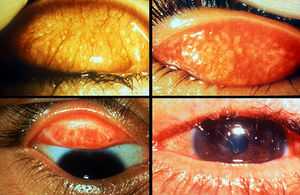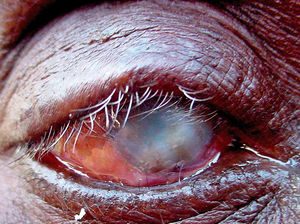We need you! Join our contributor community and become a WikEM editor through our open and transparent promotion process.
Trachoma
From WikEM
Contents
Background
- Most common cause of infectious blindness worldwide
- Caused by Chlamydia trachomatis
- Spread by direct contact, fomites (towels, clothes, bed covers), and flies (those that have landed on or near the mouth or eyes of other infected individuals)
- More than 6 million blind secondary to trachoma and more than 150 million in need of treatment
- Typically affects most marginalized populations in the world
- Those with limited access to clean water and sanitation
- Part of the group of diseases known as neglected tropical diseases
Clinical Features
Acute
- Conjunctivitis-like symptoms
- Conjunctival follicles (white lumps) on the inner upper eyelid
- Non-specific inflammation and thickening of the conjunctiva
Chronic
- Known as the "quiet disease" because of its slow chronic course
- Blindness after repeated infections
- Caused by structural changes to the inner eyelid
- Scarring of the inner eyelid that leads to buckling of the lid
- This causes the eyelashes to turn inwards (Trichiasis) and rub on the cornea causing repetitive trauma that leads to opacities and scarring of the cornea
- Scarring of the inner eyelid that leads to buckling of the lid
- Caused by structural changes to the inner eyelid
- Major complications include corneal ulcers
Differential Diagnosis
Evaluation
- Clinical diagnosis
WHO classification
- Simplified grading system composed of 5 clinical signs of infection
- Follicular trachomatous inflammation (TF)
- ≥5 follicles >0.5mm on the superior tarsal conjunctiva
- Intense trachomatous inflammation (TI)
- Hypertrophy of the papilla and inflammatory thickening of the superior tarsal conjunctiva (must obscure more than half of the deep vessels)
- Trachomatous scarring (TS)
- Scarring in the superior tarsal conjunctiva
- Trachomatous trichiasis (TT)
- One or more ingrown eyelash in contact with the globe or evidence of eyelash loss (epilation)
- Corneal opacity
- Must blur part of the pupil margin
- Follicular trachomatous inflammation (TF)
Management
- S.A.F.E. strategy proposed by WHO
- S - Surgery
- Bilamellar tarsal rotation procedure recommended by WHO
- A - Antibiotics
- Tetracycline 1% eye ointment
- Adherence issues secondary to difficulty in use and uncomfortable to apply
- Azithromycin (20mg/kg) single dose
- Relatively expensive in resource poor settings
- Tetracycline 1% eye ointment
- F - Facial cleanliness
- Helps decrease disease transmission
- E - Environmental management
- WHO emphasizes access to latrine and clean water
- S - Surgery


